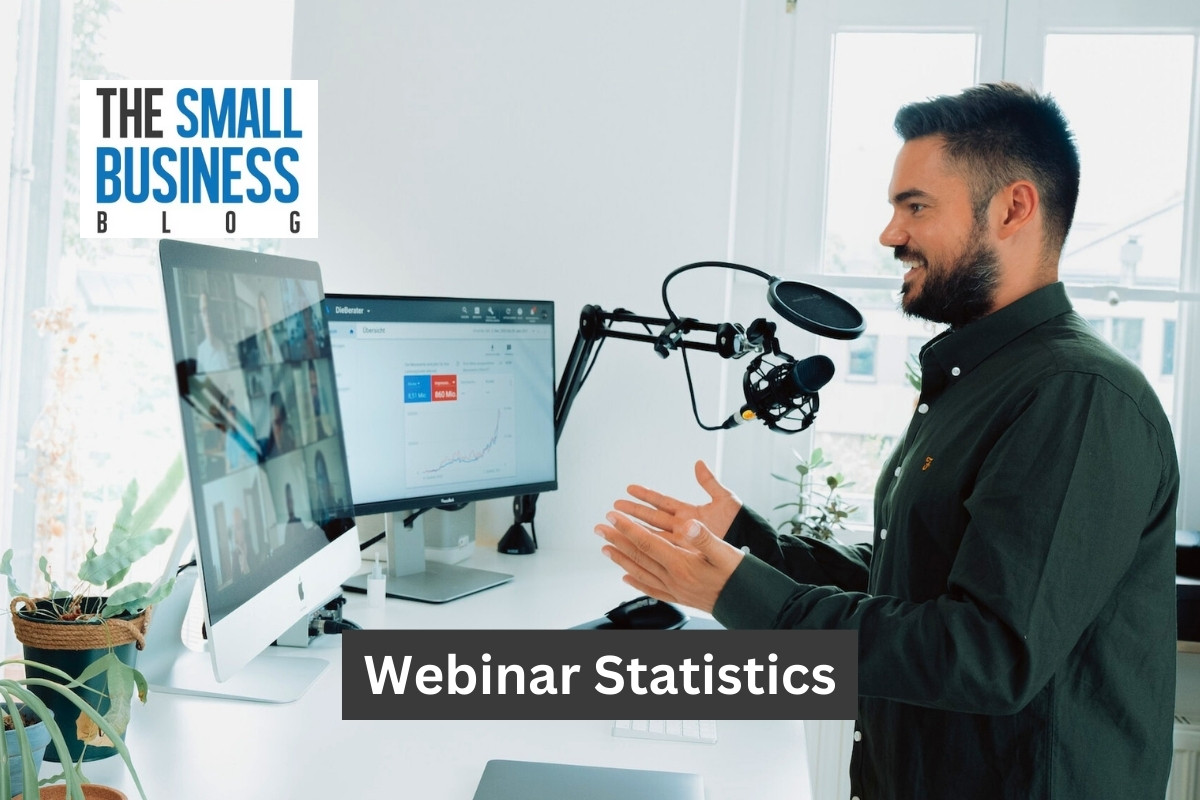A webinar is best described as an online presentation.
It is generally done in real-time, meaning that one, or sometimes more than one, person is presenting the information and others are absorbing it.
The webinar is done using video and audio, effectively creating a virtual classroom.
Needless to say, as the following webinar statistics show, these types of presentations became significantly more popular during the global pandemic.
Webinars are commonly used by teachers, whether dealing with an individual or a classroom full of people.
They are also used by businesses, especially when conducting business with different companies.
It’s important to remember that the internet has shrunk the world, meaning business executives can be based across the globe.
That can make it difficult to get everyone in the same room.
Webinars eliminate this issue as people can be anywhere, in any time zone, and still be present in the same meeting.
Post Contents
- 1 Webinars Vs Virtual Meetings
- 2 Key Statistics
- 3 Top Webinar Statistics in 2024
- 3.1 1. 83% Of Marketing Executives In The US Think Webinars Are Effective
- 3.2 2. 57% Of Marketing professionals Host Over 50 Webinars A Year
- 3.3 3. Approximately 5% Of Webinar Attendees Will Purchase Your Product Instantly
- 3.4 4. 60% Of Marketing Professionals See Webinars As A Good Way To Build Customer Loyalty
- 3.5 5. The Average Attendance For A Webinar Is 44%
- 3.6 6. 17% Of Webinar Attendees Sign Up On the Day
- 3.7 7. 47% Of Views Are Received After The Event
- 3.8 8. The Most Popular Webinars Are 60 Minutes Long
- 3.9 9. 25% Of Attendees Watch A Webinar On Their Phone
- 3.10 10. 64% Of B2B Marketing Professionals Have Done A Webinar Within The Last 12 Months
- 3.11 11. 62% Of Attendees Wanted a Demonstration After Watching A Webinar
- 3.12 12. Webinars Are Most Prevalent In The Pharmaceutical Industry
- 4 Joining A Webinar
- 5 Summing Up
Webinars Vs Virtual Meetings

On the face of it, there is little difference between a webinar and a virtual meeting or video conference.
However, webinars generally describe meetings where the main purpose is educational or instructional.
Webinars can be used to reach thousands of people simultaneously.
In contrast, video conferencing tends to be between small groups, often one-on-one.
The feel is more like a conventional meeting with ideas being shared and communication going back and forth.
If you work remotely, you’re likely to video conference or have a virtual meeting multiple times a day. Webinars are less frequent and potentially more scheduled.
As mentioned, while webinars were steadily growing in popularity, the Covid-19 pandemic caused a sudden increase in webinars as companies and individuals found ways to deal with lockdowns and remote working.
That surge of interest in webinars doesn’t appear to have abated.
Key Statistics
- 83% of marketing executives in the US think webinars are effective
- 57% of marketing professionals host over 50 webinars a year
- Approximately 5% of webinar attendees will purchase your product instantly
- 60% of marketing professionals see webinars as a good way to build customer loyalty
- The average attendance for a webinar is 44%
- 17% of webinar attendees sign up on the day
- 47% of views are received after the event
- The most popular webinars are 60 minutes long
- 25% of attendees watch a webinar on their phone
- 64% of B2B marketing professionals have done a webinar within the last 12 months
- 62% of attendees wanted a demonstration after watching a webinar
- Webinars are most prevalent in the pharmaceutical industry
Top Webinar Statistics in 2024
1. 83% Of Marketing Executives In The US Think Webinars Are Effective
Webinars have become an essential marketing tool.
They allow companies to reach hundreds, or even thousands of people simultaneously and can still create a personal touch.
That makes them the ideal option to grab potential consumers’ attention and potentially convert them into customers.
According to the latest research, the majority of marketing executives agree with this.
A survey found that 83% of marketing executives believe webinars are an effective way to reach consumers and potential consumers.
However, it’s worth noting that the research also shows that just 58% of marketing professionals are using webinars to share content.
In other words, despite the potential, many professionals are not using the webinars effectively.
Interestingly, 85% of marketing professionals confess to not spending enough time focusing on their content marketing program.
(Zippia)
2. 57% Of Marketing professionals Host Over 50 Webinars A Year
Although many marketing professionals are failing to get the webinar content right, the enthusiasm for this type of marketing is encouraging.
According to the latest market research, 57% of marketing professionals host 50 or more webinars a year.
That means over half of marketing execs are posting a webinar every week.
Some marketing professionals are more dedicated.
According to the research, 29% of marketers are hosting over 100 webinars a year.
That’s as good as two a week.
It’s likely this number will increase again as remote working remains popular, it’s the simplest way to grab the attention of multiple clients.
If you’re concerned about how many people will watch a webinar, consider this.
Before the pandemic, 54% of B2BH marketers watched at least one webinar a week.
Since the pandemic started, this figure has risen to 67% of all marketers and shows no sign of returning to its former level.
(Zippia)
3. Approximately 5% Of Webinar Attendees Will Purchase Your Product Instantly

Marketing is a game of numbers.
No matter how good you are, you’re not going to be able to turn everyone you meet into a new customer.
That’s why marketing focuses on getting the message to as many people as possible.
The higher the number of people contacted, the more likely some will convert to your product.
According to the latest figures, approximately 5% of all webinar attendees will decide to purchase what you’re offering.
That may not seem like a lot.
However, if you’ve created a webinar which reaches 250 people, that 5% represents 12 sales the moment the webinar finishes.
Alongside this, a percentage of the people will become customers in the future.
It’s hard to put an exact number on this.
However, even another 5% of attendees mean one webinar created 24 sales.
In most cases that will be classified as a good rate of return.
It’s worth noting that, on average, 15% of those who attend a webinar will purchase what you’re offering. They just won’t all purchase instantly.
That’s good news considering the average cost of a webinar is between $3,500 and $5,000.
(Zippia)
4. 60% Of Marketing Professionals See Webinars As A Good Way To Build Customer Loyalty
Webinars are more than just a way to attract customers to your brand.
A lot of marketing professionals are finding they are a great way to share information with existing customers.
Sharing helps the customer feel appreciated, which builds loyalty.
Of course, the content of the webinar needs to be seen as beneficial and that can be difficult to get right.
In a recent survey, 60% of marketing professionals agreed that webinars are one of the most effective ways to boost brand loyalty.
Customers who are introduced to the brand via webinars appreciate regular webinars the most.
It’s estimated that 73% of B2B attendees will want to know more about the business and the products you have to offer.
This makes regular webinars the perfect way to guide a potential customer through the selection process and ultimately create a loyal customer.
It’s surprising how much difference feeling appreciated makes to a customer.
(Zippia)
5. The Average Attendance For A Webinar Is 44%
When creating a webinar the first challenge is to ensure it sounds interesting, even exciting.
Its introduction and content need to attract the attention of potential consumers.
Get this right and people will want to sign up for the webinar.
However, the problem is that, according to several studies, the average attendance at a webinar is just 44%.
That means, only 44% of people who say they will attend actually do so.
This can have a serious effect on sales and leads.
For example, earlier we mentioned 250 attendees for a webinar.
If only 44% turn up this figure drops to 112.
A 5% purchase rate means only 6 people will buy a product at the end of the webinar.
This may not be enough of an ROI to justify the cost of setting up the webinar!
If you’re getting a lot of interest but low attendance for webinars you need to improve your promotional campaign.
In short, you should be targeting all attendees with emails and social media, to help maintain the interest and get people to attend the webinar.
(Zippia)
6. 17% Of Webinar Attendees Sign Up On the Day
Marketers generally spend a lot of time and effort letting people know about an upcoming webinar.
It’s important to market it in order to maximize the attendance rate.
However, there is clearly some work to be done regarding advertising.
The latest studies show that 17% of webinar attendees sign up on the day.
The question is, do these 17% of people not know about the webinar until the day or do they simply wait to sign up until the last minute?
The studies don’t currently have an answer to this.
However, it does illustrate the importance of maintaining marketing efforts right up to the commencement of the webinar.
Naturally, it is important to know what sites should be targeted to maximize potential interest.
You should note that a recent survey by Go To Meeting found that 24% of webinar registrations happen on a Tuesday.
It’s worth releasing invitations on a Monday or Tuesday to see what effect this has on attendee numbers.
Of course, inviting people at the weekend is never a good idea.
(Zippia)
7. 47% Of Views Are Received After The Event
No matter how hard you try you’re never going to find a date and time that suits everyone wishing to attend your webinar.
The simple truth is you don’t need to!
The key to a successful webinar is in creating enough publicity and generating interest.
You can then make the webinar available to people after the event has finished.
This means, anyone who couldn’t or didn’t want to sit through the webinar at that time, can still view it.
You may be surprised at how company people prefer to watch a webinar in their own time.
Recent studies show that 47% of webinar views actually happen after the event.
In most cases, views will continue to happen for ten days after the arranged event time.
After 10 days the number of views drops, but it’s possible to get as many as 10% of views up to 30 days after the webinar.
Every view is a potential sale or simply another lead for the future.
It illustrates why it’s important to make the webinar available after the official event.
It’s the simplest way to maximize your return on investment.
(Zippia)
8. The Most Popular Webinars Are 60 Minutes Long

Crafting a webinar is a difficult process.
You’ll want to get all the necessary information in, keep the attendees interested, and allow them an opportunity to ask questions.
All of that takes time but, if you take too long you’re likely to lose your attendees and any chance of a sale.
According to studies, the most popular webinars are 60 minutes long.
This fits with the statistics which suggest the average webinar attendee will view the webinar for 56 minutes.
It’s recommended you take 45 minutes to present everything, with just the first five of those minutes being used to introduce yourself.
This will leave you with 15 minutes to allow attendees to ask questions.
It’s best to answer these as succinctly as possible.
It is worth noting that any webinar which takes 90 minutes or longer is likely to lose attendees and will reduce the amount of leads/sales developed from it.
In addition, as many as 44% of webinar attendees would prefer 45-minute long webinars, and 41% of attendees prefer them to be 30 minutes.
In other words, if possible keep the webinar to 30 minutes and split your 60-minute webinar into two.
(Zippia)
9. 25% Of Attendees Watch A Webinar On Their Phone
Since 2016 accessing the internet via a mobile device has become more popular than using a desktop.
It’s because mobiles have become powerful enough to compete with a desktop, especially when doing simple tasks such as watching a webinar.
Mobile devices are also more convenient.
However, mobile devices do have batteries with limited life spans.
Alongside this, it can be difficult to hold your phone for an hour.
That’s why most attendees prefer the webinar be kept shorter so that they can enjoy it on their mobile, perhaps while commuting.
Equally, it’s generally simple to move from a webinar to a purchasing screen, especially when you’re on a mobile.
Therefore, the best marketing professionals will keep the webinar short, make sure it is mobile-friendly, and include easy links for purchasing products.
Just remember, even when opting for shorter webinars, the majority of attendees like having a question-and-answer section at the end.
Studies show 92% of attendees expect Q&As and want them to be at least 10 minutes long.
Factor that into your short webinar.
It’s a good way of keeping the webinar to the point and separating topics into different webinars.
(Zippia)
10. 64% Of B2B Marketing Professionals Have Done A Webinar Within The Last 12 Months
Webinars are becoming more commonplace in business with as many as 64% of marketing professionals confessing to having done at least one in the last 12 months.
In the past, marketing professionals have relied heavily on written materials, such as articles and posts.
However, the arrival of webinars is slowly changing the way businesses market themselves.
While written content remains important, the rise in businesses using webinars highlights how important this is likely to be for brand awareness and customer loyalty in the future.
It’s worth noting that magazine advertising is only done by 17% of professionals and in-person events are down to 19%.
The rise of the webinar is further facilitated by the quality of the leads generated.
Because no one is forced to sit through a webinar those that do already have an interest in the service or product.
That’s why 95% of marketers are using webinars to generate leads, and 52% of them feel that the quality of leads generated via webinars is excellent.
(Content Marketing Institute)
11. 62% Of Attendees Wanted a Demonstration After Watching A Webinar
Proof that webinars create good-quality leads has been shown in a recent survey by Bright Talk.
The results showed that an impressive 62% of webinar attendees requested a demo after the webinar had finished.
The survey didn’t supply details regarding how many went on to purchase the item.
However, the mere fact that over 50% of people were interested shows that webinars are an essential lead-generating tool.
The survey also found that 89% of webinar attendees went on to visit the website of the business, their main aim was to find out more about the webinar product and the company in general.
Of those who went on to visit the website, 86% were found to have downloaded resources and other information.
It was noted that 83% of attendees shared the content of the webinar with colleagues.
Over half of webinar attendees, 62% to be precise, also wanted to know more about the pricing structure. That’s a clear indication of intent to buy.
(Bright Talk)
12. Webinars Are Most Prevalent In The Pharmaceutical Industry

Webinars have started appearing in every industry you can think of.
This isn’t surprising as businesses realize how beneficial they are.
However, it may interest you to know, going by attendee rates, that the pharmaceutical industry is leading the field.
According to the latest statistics, pharmaceutical webinars have a 63% attendance rate, much higher than the average.
The consulting industry takes second place with a 50% attendance rate while the SaaS industry matches the average of 46%.
However, what is most surprising considering how marketing professionals are getting on board with webinars, is that the advertising industry has a 33% attendance rate.
It may be time for these businesses to focus on this sector a little more.
(Livestorm)
Joining A Webinar
If you want to join a webinar then you’ll need to complete the following steps.
- Get Invited!
People need to be invited to a webinar.
This often happens via email and gives the subject of the webinar, when it will be, and how long it is likely to last.
If you’re registered with the webinar provider you’ll get an email inviting you to the webinar.
If you haven’t got an invite but would like to attend you’ll need to visit their website or message the host to see if it is possible to attend.
When webinars are presented for anyone to access you’ll often find out about them on social media or via a blog.
Keep your eyes open!
- Register
If you receive an email inviting you to a webinar and you want to go then you need to click on the link within the email.
If you’ve found out about the webinar from somewhere else there should be a link allowing you to sign up.
In both cases, you’ll be taken to a page where you’ll need to enter a few details, such as your email address, name, and perhaps some other contact details.
If the webinar has a cost attached to it you’ll also need to add credit card or PayPal details.
Some webinars will even let you pay using cryptocurrencies.
- Join At The Right Time
Just before the webinar begins you should get a reminder, usually via email.
You can then visit the designated page and use your email and the password given to you by the webinar organizer.
You will need a good quality internet connection.
You’ll then be connected and able to listen and watch the presentation.
It should be as easy to follow as sitting in a lecture hall.
Summing Up
The above webinar statistics clearly show that this type of interaction with clients and potential consumers is becoming more popular.
It’s not hard to see why.
The world is becoming increasingly digital.
It’s practical, efficient, and loses the human touch.
Yet, humans are generally social creatures.
Webinars bring back the human touch in a way that can be controlled by the attendee.
That helps them feel connected to a business and, therefore, more interested in what they have to offer.
Webinars will become more common across industries, all you have to do is figure out the right approach for your customers and keep the webinar comparatively short.
This will help to ensure your webinars do what you intend them to, boost brand awareness, customer loyalty, and sales.






























